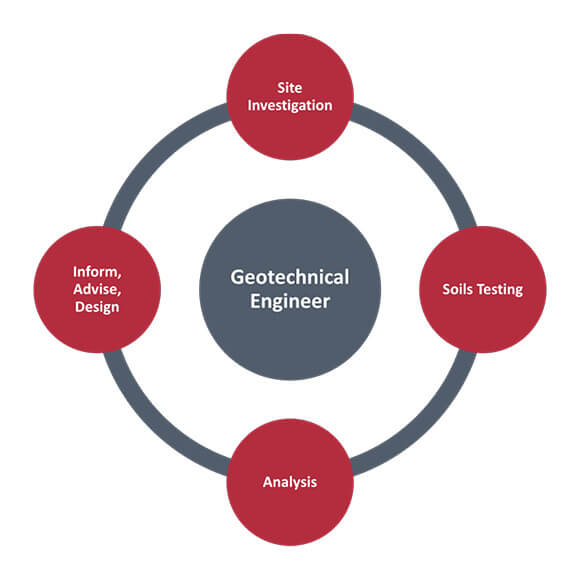The Only Guide to Geotechnical Engineering For Construction Projects
6 Simple Techniques For Geotechnical Engineering For Construction Projects
Table of ContentsThe 9-Minute Rule for Geotechnical Engineering For Construction ProjectsGeotechnical Engineering For Construction Projects for BeginnersNot known Facts About Geotechnical Engineering For Construction ProjectsGeotechnical Engineering For Construction Projects Things To Know Before You Get ThisHow Geotechnical Engineering For Construction Projects can Save You Time, Stress, and Money.Geotechnical Engineering For Construction Projects - The Facts
The role of geotechnical design significantly handles recognizing the functions of soil and rock, which might differ substantially by their thickness, moisture material etc. These features have to be examined by geotechnical designers to forecast their activities under various situations. The security in addition to stability of frameworks are affected by soil conditions, making this analysis essential.A geotechnical designer will certainly take a look at soil to establish the bearing capability of the earth and recommend proper foundation kinds, such as shallow structures, deep structures like piles, or specialized solutions like drifting foundations for soft dirts. Understanding the features and activities of soil and rock, in enhancement to how they interact with building and constructions that have been put up on or within them, is among the primary descriptions for why geotechnical design is necessary.
Environmental protection is achieved through geotechnical engineering. Expertise in air, water, and soil quality maintenance is placed to make use of by geotechnical designers to lessen the unfavorable impacts of jobs.
Framework advancement, offshore engineering, tunnel construction, and deep foundations. Risk-based layout and multidisciplinary groups. These elements will keep the field progressing and guarantee its continued significance in the years to come. To sum up, geotechnical engineering is an important self-control that preserves the resilience and integrity of civil infrastructure. Geotechnical engineers add to making building jobs efficient all over the globe by understanding the behaviour of planet products and applying appropriate preparation approaches.
The 10-Minute Rule for Geotechnical Engineering For Construction Projects
By taking a look at dirt, rock, and subsurface conditions, geotechnical engineers supply essential insights that assist in the layout, building and construction, and maintenance of buildings and facilities.

Facts About Geotechnical Engineering For Construction Projects Revealed
Laboratory testing: Figuring out the homes of soil and rock. Area screening: Carrying out tests on-site to evaluate conditions. more information Analysis and design: Utilizing information to design foundations, keeping wall surfaces, tunnels, and various other frameworks. Several prominent construction tasks have actually efficiently used geotechnical design to ensure their stability and safety. :: The globe's highest structure needed a deep understanding of the underlying geology.

As a leader in geotechnical design, BECC Inc. is committed to supplying ingenious and effective options that satisfy the highest standards of quality and safety., a mechanical engineer and rock hound.
An Unbiased View of Geotechnical Engineering For Construction Projects
Terzaghi likewise established the structure for theories of bearing capacity of foundations, and the theory for prediction of the rate of settlement of clay layers because of combination. Later on, Maurice Biot completely established the three-dimensional soil combination theory, extending the one-dimensional design formerly created by Terzaghi to extra basic theories and presenting the collection of fundamental equations of Poroelasticity.
Geotechnical designers explore and figure out the properties of subsurface conditions and products.
All About Geotechnical Engineering For Construction Projects
Geologic mapping and analysis of geomorphology are usually finished in consultation with a geologist or engineering geologist. Subsurface exploration normally includes in-situ screening (for example, the basic penetration examination and go to these guys cone penetration test). The digging of examination pits and trenching (particularly for locating faults and slide airplanes) may likewise be utilized to find out about soil conditions at depth. , which utilizes a thick-walled split spoon sampler, is the most typical method to collect disrupted examples.

If the interface in between the mass and the base of a slope has a complex geometry, slope security analysis is difficult and mathematical option techniques are required. Normally, the interface's specific geometry is unidentified, and a simplified user interface geometry is assumed. Finite slopes call for three-dimensional models to be analyzed, so most inclines are examined presuming that they are definitely large and can be represented by two-dimensional models.
Things about Geotechnical Engineering For Construction Projects
Producing the style based on a working hypothesis of actions anticipated under the most possible problems. Choice of amounts to be observed as construction proceeds and calculating their anticipated worths based on the functioning hypothesis under the most undesirable conditions.
Dimension of quantities and examination of real conditions. Design alteration per actual conditions The observational approach appropriates for building and construction that has actually already begun when an unforeseen growth happens or when a failing or accident looms or has currently happened. It disagrees for tasks whose style can not be changed throughout construction.